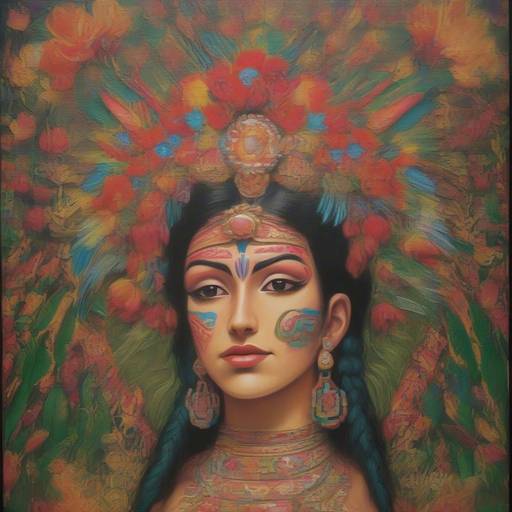
Introduction
In the rich Aztec mythology, Xochiquetzal emerges as the revered deity of beauty, fertility, and arts. His influence transcended the borders of the Aztec pantheon, becoming an inspiration around the world. Join us on this journey through the mysterious world of Xochiquetzal, where we will discover the deep connection between "flowers", "mariposas", and "tejedoras", fundamental elements in the life and legacy of this powerful goddess.
History and Background
The legacy of Xochiquetzal dates back to the very origins of ancient Aztec civilization. Its influence was manifested in the lush beauty of the flowers, the delicate dance of the butterflies, and the ability of the weavers to create exquisite pieces of art. These elements not only represented their divinity, but also inspired mortals to seek perfection in their daily lives. The veneration of Xochiquetzal was related to the cult of fertility and the enjoyment of life in all its manifestations, making it one of the most dear and revered deities.
Analysis in Deep
Flowers
The flowers had a deep symbolic meaning in the Aztec cosmovision. They represented beauty, fragility of life and constant renewal. The goddess Xochiquetzal was intimately linked to the corn flower, symbolizing fertility and abundance. In the festivities dedicated to the goddess, the flowers were used in elaborate offerings and decorations, reflecting their close association with life and beauty.
Butterflies
The delicate dance of the butterflies embodied transformation, rebirth and freedom. The Aztecs believed that the souls of the fallen warriors returned in the form of butterflies, thus symbolizing the constant evolution of existence. This connection between butterflies and spirituality was fundamental in Xochiquetzal mythology, revealing its role as protector of life and encouraging personal growth.
Weavers
The ability of the weavers to create intricate pieces of art symbolized the creativity and skill that Xochiquetzal encouraged in mortals. The art of the fabric was considered a way of venerating the goddess, since each intertwined thread represented an offering to its divinity. This connection between weavers and Xochiquetzal leads us to a deeper understanding of their influence on the arts and human creativity.
Comparative analysis
The interconnection between "flowers", "mariposas" and "tejedoras" as fundamental elements in the Xochiquetzal cosmovision allows us to appreciate the complex network of meanings and symbolisms that shaped their cult. Each of these elements represented an essential aspect of human existence, from fertility and beauty, to transformation and creativity. Through this comparison, fascinating parallels emerge that reveal the depth of Xochiquetzal's influence in the daily life of the Aztecs.
Conclusions and FAQs
The influence of Xochiquetzal, the goddess of beauty and arts, transcends time and space, leaving an eternal mark on Mesoamerica's culture and spirituality. His legacy endures in the delicate dance of the butterflies, in the lush beauty of the flowers, and in the creativity of the weavers, reminding us that the search for fertility, beauty and creativity is inherent in human experience.
FAQs
**1. What is the symbolism of flowers in Aztec mythology?**In Aztec mythology, flowers represented beauty, renewal and fertility. They were used in religious ceremonies and rituals as offerings to deities, being a symbol of the connection between humans and the divine.
**2. What does butterfly represent in Aztec mythology?**The butterfly was seen as a symbol of transformation and rebirth, associated with the idea of spiritual evolution and the freedom of the soul. It was believed that the souls of the dead became butterflies, thus uniting the cycle of life and death.
**3. What is the importance of tissue in Aztec culture?**The art of the fabric was highly valued in Aztec culture, being considered not only as a practical skill, but also as an artistic expression. The weavers created beautiful textiles that reflected the complex Aztec cosmovision and were used for religious ceremonies and special clothing.
**4. How did Xochiquetzal influence Aztec art and creativity?**Xochiquetzal was considered the divine source of beauty and creativity, inspiring Aztec artists and craftsmen in the creation of works of art that reflected their divinity. His influence was manifested in the exquisite craftsmanship and artistic representations of nature.
**5. What were the holidays dedicated to Xochiquetzal?**The festivities dedicated to Xochiquetzal included rituals and ceremonies to honor their role as a goddess of beauty, fertility and arts. These celebrations were accompanied by offerings of flowers, sacred dances and artistic representations in their honor.
**6. How does Xochiquetzal relate to the daily life of the Aztecs?**Xochiquetzal was intrinsically linked to the daily life of the Aztecs, influencing the aesthetics, creativity and spiritual beliefs of his culture. His presence was manifested in the way the Aztecs appreciated the beauty of nature, the art of tissue and the connection with the spiritual world.
In conclusion, the figure of Xochiquetzal transcends the time to inspire and captivate the wealth of its legacy, connecting the threads of beauty, fertility and creativity throughout the generations. Its influence endures in the delicate dance of the butterflies, in the lush beauty of the flowers and in the creativity of the weavers, reminding us that the search for fertility, beauty and creativity is inherent in human experience.
